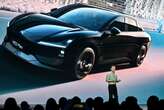Five days before Donald Trump defeated Hillary Clinton to win the 2016 U.S. presidential election, I wrote a story that turned the presidential politics clock back to 1992. That was the first year the campaign had a digital element—particularly for underdog candidates such as former Irvine, California, Mayor Larry Agran. Unable to get mainstream news outlets to pay attention to his bid, Agran did something no would-be president had ever done. He held a press conference that was virtual, because it took place on CompuServe, the largest online service of the time.
Agran went on to get fewer than 60,000 votes in Democratic primaries. But other candidates also added a digital element to their campaigns, including President George H.W. Bush and Democratic nominee Bill Clinton. An article in CompuServe’s print magazine said such high-tech outreach efforts might help transcend “politics’ high-gloss superficiality and the ‘sound-bite’ orientation of the mass media.” In a term redolent of the dial-up age, it called the trend “modemocracy.”
In retrospect, there’s something touchingly naive about those early expectations. Some 32 years later, a massive chunk of how we experience presidential elections has moved online. Yet the process has hardly grown more sober and fact-oriented as a result. Particularly since the advent of social media, it’s gotten even shallower, as takes, screeds, and clips scroll by in our feeds, sometimes interspersed with misinformation and outright disinformation.
That brings us up to 2024, and the first presidential election of the generative AI era. As the year began, a deepfaked President Joe Biden robocalled New Hampshire voters telling them not to vote. Trump, once again the Republican nominee, has both shared deepfakes and falsely accused Vice President Kamala Harris of using AI to fake a rally crowd. On X, Elon Musk shared a video featuring a synthesized Harris voice without making clear it was a parody; he also unveiled a new image generator that users immediately put to work creating imaginary photos of Trump, Harris, and others in improbable situations.
Most of this presidential election’s fakes haven’t been terribly convincing if you’re paying attention; we’re probably lucky that the technology hasn’t been used to even more chilling effect (so far). Still, like social networking before it, artificial intelligence shows no signs of ennobling the sacred rite of American democracy in action.
You can’t fault 1992’s techno-optimists for not anticipating the advent of deepfakes decades later. They also wouldn’t have known what to make of pressing 2024 online debates such as whether Harris is brat. But even in the early ’90s, it occurred to some people that the online services of the time didn’t exactly reflect American society at large. An article by Businessweek’s Evan I. Schwartz quoted Clem Bezold, executive director of the Institute for Alternative Futures think tank: “How many poor people have Prodigy or CompuServe?” Even among more affluent types, going online was a pricey, fairly exotic hobby—CompuServe, the biggest of the services, cost $12.80 an hour and had fewer than a million users, not all of whom partook in its political aspect.
Today, our digital culture still bears only so much resemblance to life in its traditional form. Among the terminally online, 2020 Democratic contender Andrew Yang and 2024 Republican Vivek Ramaswamy were favorite sons of their respective races. Outside that bubble, neither fared anywhere near so well among voters at large. Maybe you think that proves something is broken about our electoral politics, but it’s still evidence of a disconnect.
Of course, the internet isn’t one big bubble—it’s a bubble of bubbles. Last week, when Musk conducted a “super unscientific” presidential poll of his X followers, Trump (whom Musk has endorsed) crushed Harris, 74% to 26%. That result says more about Musk’s fan base than it does about the consensus of all X users, and I feel slightly dumber just for having paid attention to it at all. Especially after I dredged up a June 1992 column by the St. Louis Dispatch’s William F. Woo, who thought the fact that 57% of CompuServe users supported third-party candidate Ross Perot might mean an epoch-shifting moment in American history was imminent. (Only 8% of CompuServers favored Clinton, the eventual winner.)
As happy as I am not to get sucked too deeply into Musk’s particular bubble, I also worry about growing too attached to one of my own. The internet is much better at creating feedback loops than enabling the sort of shared reality that the democratic process requires, a defining dysfunction of our times that was hard to foresee in 1992.
To be clear, I’m not saying I want to go back to the days when presidential campaigns were filtered almost exclusively through newspapers, magazines, broadcast TV and radio, and maybe an all-news cable channel or two. I’ve been gorging on coverage of this year’s extraordinary election that could never have existed in those days, and am pretty much addicted to podcasts on the subject. But to quote Linus, there’s no heavier burden than a great potential. And for all the ways the online world has changed our lives for the better, most of modemocracy’s promise remains unfulfilled.
You’ve been reading Plugged In, Fast Company‘s weekly tech newsletter from me, global technology editor Harry McCracken. If a friend or colleague forwarded this edition to you—or if you’re reading it on FastCompany.com—you can check out previous issues and sign up to get it yourself every Wednesday morning. I love hearing from you: Ping me at [email protected] with your feedback and ideas for future newsletters.










No comments